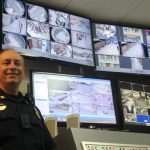New London increases security
By Scott Bellile
As communities nationwide continue to grapple with school shootings, New London will introduce two part-time liaison officers into its elementary and middle schools this fall.
The New London School Board on May 14 unanimously approved committing $15,000 to fund most of the salary for one new part-time school resource officer position during the 2018-19 school year. New London Police Department will contribute between $15,000 and $20,000, which will fund any remainder of that officer’s salary as well as the entire salary for the second SRO.
“When you look at the investment, it is a high rate of return, in our opinion, of what can we have to further ensure safety in our schools,” said Joe Marquardt, the School District of New London’s director of business services.
One part-time officer will work at a time, alternating between three full-day shifts (24 hours) one week and two full days (16 hours) the next week.
The officers will be paid $20 per hour and work approximately 720 hours per school year. They will not receive benefits or be union members.
The SROs’ duties will include patrolling the schools; handling incidents involving bullying, drug and alcohol use, sexual abuse and child predation; rendering first aid and life support; and presenting on safety to classrooms and faculty.
The school district currently employs a full-time SRO, Officer Chris Dearth, at a cost of $60,000 to cover all of the schools alone.
Police Chief Jeff Schlueter explained the problems this current setup causes on May 2, when he advised the New London and Finance and Personnel Committee of NLPD’s plans to reallocate dollars to support the SRO position.
“If we have a kid that spits on the floor for example at the elementary level and they call the liaison officer, we pull him out of the high school for anywhere up to about an hour, an hour and a half of time, once you start dealing with travel time, dealing with the kid, taking care of the report, getting back up to the high school. We want to eliminate that as much as possible,” Schlueter said.
With an older student body, NLHS is considered the most at-risk school. Having a part-timer on the job all day will allow Dearth to stay at New London High School most of his time.
The two new SROs would spend half their time at New London Intermediate/Middle School and half the time at any of the four elementary schools: Parkview, Lincoln, Readfield and Sugar Bush.
The SROs will have the authority to carry weapons and make arrests but will never work outside the schools, Schlueter told the New London Police and Fire Commission in April. Major investigations in the schools will be handled by a patrol officer or detective because NLPD does not want SROs spending time in court.
NLPD will pay for the second SRO using the savings recently gained by redirecting weekend dispatch hours to the sheriff’s department, Schlueter said.
The New London Police and Fire Commission was scheduled to approve the SRO job description on Monday, May 21. Schlueter said he would post the job as soon as possible in hopes of getting the SROs hired by August. The hiring timeline will depend on how many applicants apply for the part-time positions.
Dearth has not been the only police presence in schools. NLPD patrol officers performed around 430 routine walkthroughs last year, Schlueter told the finance and personnel committee. Recently Waupaca County sheriff’s deputies started walking through, too.
Schlueter introduced walkthroughs seven or eight years ago after wondering why NLPD did nightly walkthroughs at bars but never at schools, he said. Students have warmed up to the SRO, often saying hello and offering high-fives. Those relationships have helped in gathering tips to solve crimes.
School safety grants
As a separate school safety measure, last month the School District of New London applied for a grant through the Wisconsin Department of Justice’s new $100 million School Safety Grant Initiative.
Laurie Schmidt, director of pupil services for the district, told the school board on May 14 the district identified four areas to improve security: school corridors, main entrances, classroom door locks and security cameras.
Superintendent Dennis Krueger said school districts cannot use the School Safety Grants to hire personnel, but the district applied in hopes of securing dollars to upgrade facilities in conjunction with expanding its SRO presence with NLPD.
The DOJ will begin awarding School Safety Grants in June.
State legislators passed the School Safety Plan in March. Some of the plan’s components include establishing the $100 million grant program, forming the DOJ’s Office of School Safety and requiring mandatory reporting for threats of school violence.
The Educator’s School Safety Network recently identified Wisconsin as a top 10 state of concern for school safety. Between August and December 2017, the number of violent incidents and threats in Wisconsin schools increased almost 14 percent from fall 2016, according to ESSN.
Safety coordinator: NL has safe schools
In the aftermath of the high school shooting in Parkland, Florida, NLHS Principal Brian Yerkey told the school board in February that he believes the district’s school safety measures are “in a much better place” than a majority of school districts based on conversations he has had with outsiders.
“Is there room for improvement? Absolutely. There always is,” Yerkey, who serves as the school district’s safety coordinator, told the school board on Feb. 26. “But when I look around at what we’ve done the last handful of years in improving safety, it’s been fantastic.”
In a presentation to the school board, Yerkey highlighted ways New London keeps schools safe.
Physical safety features include the recently installed secured front entrances, key fob doorways, security cameras that feed to the police station, and computer software that can alert staff of suspicious internet activity on high-schoolers’ Chromebook devices.
Meanwhile, preventative measures include comparing safety plans with other schools, sharing lockdown and evacuation procedures with students and staff, conducting background checks on transfer students, requiring escorts for daytime visitors, and perhaps the most important: earning students’ trust by talking to them.
“They’ll notify you if they see something on the internet or if a friend makes an off-the-cuff remark, or that student who may commit one of these [acts of violence] has trust in you and can come talk to you and help them with their issues,” Yerkey said.
Asked by board member John Heideman whether the school district has encountered any dangerous “close calls,” Yerkey declined to answer. But he said staff use information such as student discipline referrals to predict and prevent incidents.
Two solutions commonly proposed to secure schools safer are metal detectors and arming teachers.
Yerkey’s views on each: The district’s preventative measures are more effective than metal detectors would be. As for arming teachers, “until it’s legal I won’t entertain the discussion,” he said.


